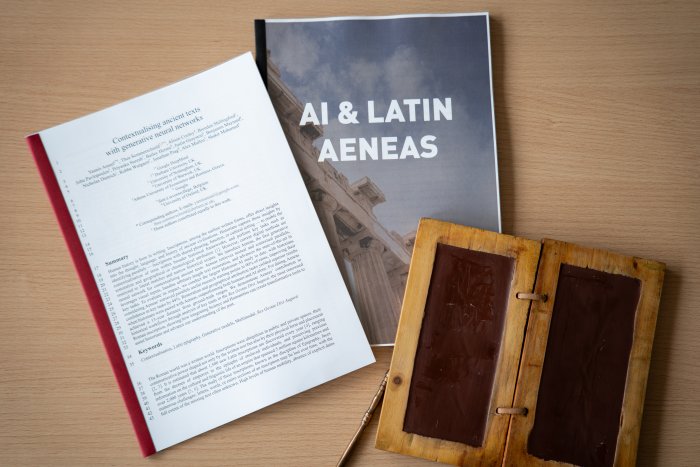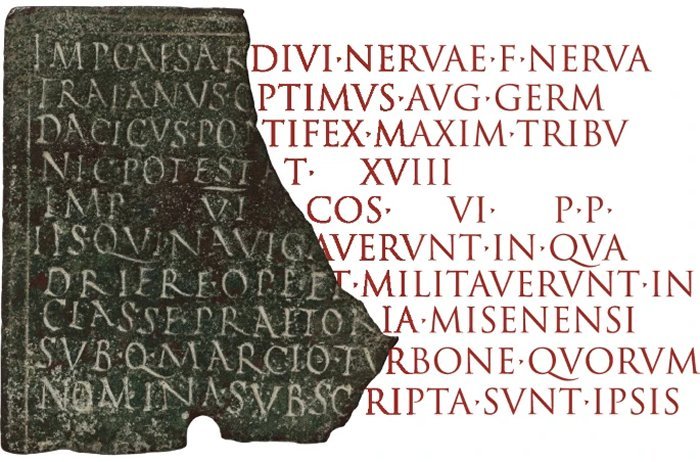Conny Waters – AncientPages.com – Google DeepMind has developed an artificial intelligence program called Aeneas that helps historians restore damaged Latin texts by analyzing thousands of Latin inscriptions.
Image credit: University of Nottingham
Google DeepMind has developed an artificial intelligence program called Aeneas that helps historians restore damaged Latin texts by analyzing thousands of Latin inscriptions.
Aeneas was named after a hero from Greek and Roman mythology. Mentioned in Homer’s Iliad, Aeneas – according to Greco-Roman mythology – was a Trojan hero, the son of the Trojan prince Anchises and the Greek goddess Aphrodite (equivalent to the Roman Venus).
Approximately 1,500 Latin inscriptions are uncovered on buildings and antiquities each year. However, the majority of these inscriptions are often incomplete due to damage or erosion. Researchers seek out these inscriptions with the aim of reconstructing lost words and sentences. So, this work is highly time-consuming and requires the examination of hundreds of texts.
‘Aeneas’ tool can be of great help because it can predict a missing text, even if it doesn’t know its length. The tool also suggests a likely place of origin, finds similar inscriptions, and determines the date of their creation – sometimes with an accuracy of 13 years.
Aeneas achieves an impressive 72% accuracy in predicting the correct Roman province of origin.
Illustration of the first part of the Res Gestae Divi Augusti. CC0 1.0 Universal Public Domain
For this purpose, artificial intelligence searches for similar examples in a database of 176,861 Latin inscriptions, which contains 16 million characters, from various regions of the ancient Roman Empire.
Google DeepMind co-developed ‘Aeneas’ in collaboration with the University of Nottingham and in partnership with researchers from the Universities of Warwick, Oxford, and the Athens University of Economics and Business (AUEB).
Ancient inscriptions provide rare, direct insights into past civilizations, but they often survive as incomplete fragments. We’ve developed Aeneas, an AI model that transforms how historians approach these texts, according to Dr Thea Sommerschield, Leverhulme Fellow, Department of Classics and Archaeology at the University of Nottingham, who worked on a project with Google DeepMind.
Fragment of a bronze military diploma from Sardinia, issued by the emperor Trajan to a sailor on a warship. 113/14 CE (CIL XVI, 60, The Metropolitan Museum of Art, Public Domain
“Much like finding connections between jigsaw pieces, Aeneas quickly identifies shared names, phrases, and formulas across thousands of Latin inscriptions, enabling us to reconstruct lost information and gain a more complete understanding of ancient history.”
The Aeneas’ tool can also be adapted to other ancient languages, scripts, and media, from papyri to coinage, expanding its capabilities to help draw connections across a broader range of historical evidence.
The tool works with the inscriptions from the seventh century BC to the eighth century AD, originating from the Roman provinces of Britannia (modern-day Britain) and Lusitania (Portugal) in the west, to Aegyptus (Egypt) and Mesopotamia (Iraq) in the east
To test the tool, the team examined Res Gestae Divi Augusti, a large Latin inscription from the time of Emperor Augustus, engraved on the walls of the Temple of Augustus and Roma in Ankara. The exact date of its creation has long been debated among historians, but ‘Aeneas’ managed to establish dates consistent with the estimates of scholars and similar inscriptions.
The tool also examined an altar inscription from Mainz, Germany, discovered in the city of Mogontiacum (modern-day Mainz) in 1895 during excavations of a city center road, and correctly dated it to 214 AD, and identified the province of Germania Superior, and proposed a method for reconstructing the damaged text.
Written by Conny Waters – AncientPages.com Staff Writer




